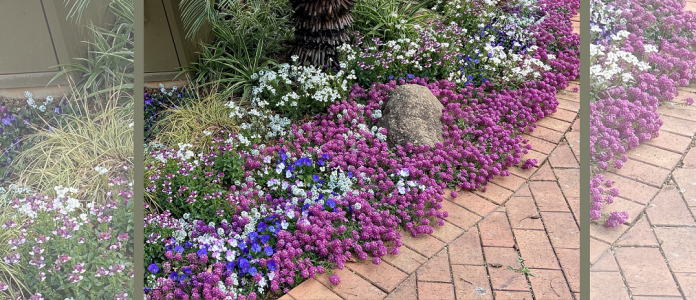It’s a no-brainer. Growing flowers from seed is less expensive than buying trays of seedlings, and that is especially true for garden flowers that show off best when planted en masse like alyssum, marigolds, lobelia and zinnias.
Another benefit of going the seed route is the wide variety of garden flowers to choose from. Seed varieties also offer a greater choice of colours and many of the old fashioned favourites are heirloom varieties.
Getting started (tips from Kirchhoffs)
- For sun loving annuals to flower well, choose a position receives at least six hours of sun a day. Some, like lobelia, forget-me-not and alyssum will be happy with morning sun and afternoon shade.
- Prepare the area by breaking down clumps of soil and remove sticks and stones. Work in generous amounts of compost to improve fertility and drainage.
- Rake the soil until it’s level and the texture is fine, which ensures better germination. Water and leave overnight for sowing the next day when the soil is still damp, but not too wet.
- Read the instructions on the back of the seed packet. It tells you depth of sowing, and spacing.
- To sow the seed evenly, mix the seed with vermiculite or mealie meal so that the seed sticks to it and you can see how the seed falls. Use your hand or a plank to press the seed into the soil, cover with a light sprinkle of soil and firm down again. This prevents the seed from blowing away.
- Damp the soil using a watering can with a fine nozzle. Lightly swish the water over the bed. Start and finish the watering away from the bed because the heavy drops at the beginning and end of watering can displace the seed.
Very important: Don’t let the soil dry out while the seeds are geminating. When the little growing tips emerge from the seeds they dry out very quickly unless the soil is moist. In very hot weather water lightly twice a day or cover the beds with shade cloth, slightly raised above the ground.
Try these easy to grow flowers

For fragrance, you can’t beat Kirchhoffs Alyssum ‘Snow Carpet’ (white) and Royal Carpet’ (purple). They produce masses of tiny honey-scented flowers that cover the low spreading plants. They are perfect for borders, edgings and rockeries. Sow twice a year for almost continuous flowers. Space plants 10cm apart. They are ready to flower within 45 days.

Black Eyed Susan (Thunbergia Alata) is a naturally vining indigenous creeper that grows and flowers quickly for covering a trellis, obelisk, pergola or along a fence. It does need to be trained as it doesn’t naturally cling to a support. It can also be grown in a hanging basket. It flowers prolifically throughout the year and grows in both full sun and partial sun, is drought tolerant and tolerates most garden soils. A monthly application of fertiliser will keep up its flower power.

There are very few flowers that can match the true blue of lobelia. These grow-anywhere, plant anytime annuals are the quintessential edging plant. The two seed varieties are Kirchhoffs ‘Crystal Palace’ which has dark blue flowers on dark foliage and ‘String of Pearls,’ which is a mix of colours including white, pink, lavender and dark blue.
Lobelia grow in full sun or semi shade and like loose, gritty soil. Conventional growing wisdom says they should be spaced about 20cm apart, but why not break the rules and plant them even closer together for quick, maximum impact.

Chrysanthemum ‘Dwarf Paludosum’ also known as Creeping Daisy produces masses of tiny white daisy flowers with a golden centre. Being very low growing, this flower is ideal for growing between pavers, in containers, as a border and on sunny pavements. Butterflies and bees love the flowers which can be deadheaded to prolong flowering.
There’s also a yellow dwarf daisy, Chrysanthemum ‘Dwarf Multicaule’ that produces a profusion of tiny single yellow blooms and can be used in the same way.

Marigolds are easily the hardiest flowers for sunny, summer gardens. They grow in ordinary garden soil and once established are drought and heat tolerant, providing vibrant non-stop colour. They respond well to fertilising once a month.
Kirchhoffs Marigold ‘Dwarf Lemon Drop’ has canary yellow flowers on short, compact plants. Scatter sow them for a burst of colour or use them as a low border in front of taller plants. Yellow marigolds combine well with dark red or purple flowers, their opposites on the colour wheel. For a mix of yellow, red and bicoloured blooms, there’s ‘Bonita Choice Mixed’ that is also compact, growing 30cm high.

Myosotis (Forget me not) produces masses of small sky-blue blooms from late spring into summer and again in autumn. It’s a low growing border plant, about 35-40cm high. It grows in sun or semi-shade although it very hot areas it prefers semi-shade. Plants grow in almost any soil that drains well and the soil should be kept moist. Space plants 25 to 35 cm apart.

Zinnias are very drought tolerant and the ideal annual to plant in the heat of summer. Kirchhoffs ‘Thumbelina Mixed’ is a dwarf variety that is suited for bedding while ‘Lucky Day Mixed’ is a taller variety for growing as a garden cut flower. It is better to sow seeds directly into the flowerbed if you want a longer flowering period. Cover the seeds with about 6-10mm of soil and space the plants about 45cm apart depending on the variety. Keep the soil moist during germination.
TEXT: Alice Coetzee






